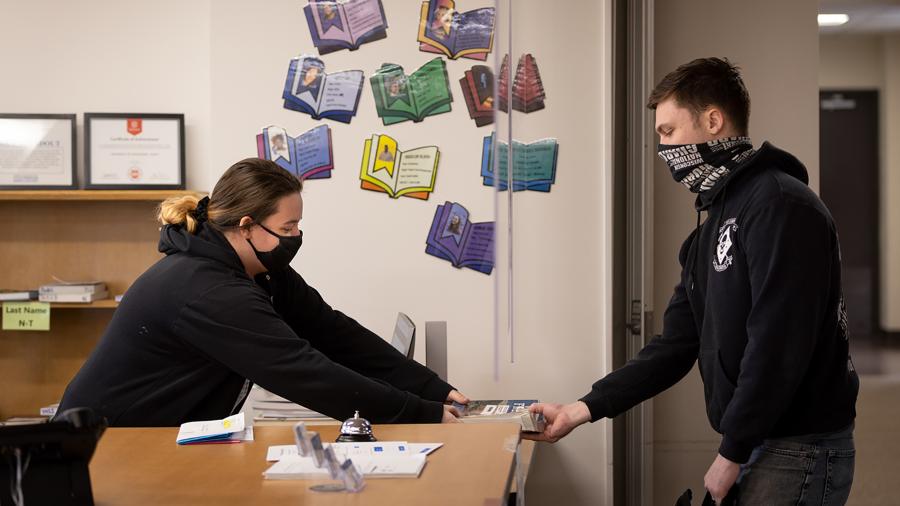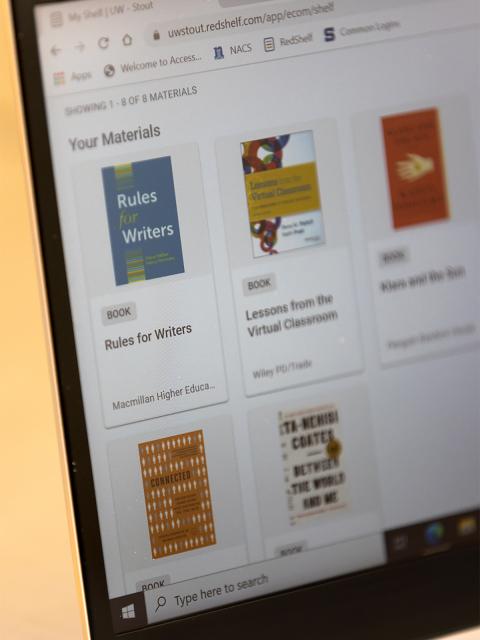One of the rites of passage for a college student is to wait in line to pick up textbooks, then stuff the often heavy, hardcover tomes into a backpack. And lug them around campus and beyond all semester.
At University of Wisconsin-Stout, the lines at the textbook rental center have all but disappeared. It’s a new age for textbooks — the digital age.
If students’ backpacks look a little less full on campus, it’s because they are — 75% less. This semester, the average full-time student has six to seven digital textbooks and just two traditional, printed texts, according to Bob Butterfield, director of Instructional Resources Service in the library.
“We let students know they don’t have to come and stand in line anymore,” Butterfield said.

IRS has issued 30,000 digital text downloads and only about 10,000 printed texts for the spring semester, which began Jan. 24. When digital texts are available, students are notified by email, log in to an account and download their books onto their university-provided laptop computer — no wait and no weight. Or they can access the text remotely with their phone or other electronic device.
UW-Stout has become a digital text leader in the UW System and nationally but not overnight. Ten years ago, Butterfield helped start an e-textbook pilot program in eight class sections. The effort has grown annually as digital texts become more available, students and professors adapt and costs are streamlined.
One of the students who loves digital texts is Kacey King, a junior from Amery majoring in human development and family studies and who works part time in IRS. She has six digital and two printed texts this semester. Despite never having used a digital text before coming to UW-Stout, she wouldn’t go back to printed books.
“They can be accessed from anywhere; there's no need to worry when you forget your textbook since you can access it from your computer, or even your phone,” King said. “Also, I love the different advantages that digital textbooks bring.”
Last semester, to prepare for a final exam in a speech class, she used the audio text feature, built-in flash cards and digital highlighting tools. Students can switch to audio text, for example, and get assigned reading done while driving home for the weekend. The audio option also helps students with disabilities.

“Being able to read the book while listening to it with the text-to-speech option helped me retain more information, and I felt more prepared for the final,” King said.
If students have poor internet access, they can use the downloaded textbook file. The eStout Laptop Program, which began 20 years ago, provides laptop computers to students and is the foundation for a campuswide digital learning environment.
Butterfield says students such as King who prefer digital texts are the norm. “At first, they were reluctant and wanted to cling to print. Now, we see the reverse. Students ask for digital if they have a print book assigned,” Butterfield said.
“For students who struggle with digital, we keep print books of every title on hand, but usually only two because we don’t get the requests.”

Kenny Mullins, an assistant professor of accounting in the business department, has been using digital texts for a decade, starting with one. This semester all five of the texts he’s using are digital.
Digital texts function much like printed texts, he said, with key advantages being accessibility, portability, the audio option and reduced cost. Students with vision issues appreciate being able to increase the size of the text they are reading, he said.
A drawback with digital texts is that during class students generally need to be on their computers. “I don’t know what’s on their machine when I’m lecturing,” said Mullins, who would like to see a browser that can lock down other content when a digital text is open.
Kevin Doll, associate professor of human development and family studies, started with 25% digital texts eight years ago. This semester, all but one of his texts is digital and only because it’s not available as digital.
“I may be biased, but I am a fan of etexts. Less space is cluttered up, very portable and accessible from a variety of devices, fewer trees destroyed, and they just add a degree of flexibility and new ways to interact with the material,” Doll said.
It’s always challenging to get students to read, he said, but the audio text, embedded videos, instructor’s ability to highlight sections, accessibility on various platforms and other features help engage students.
Digital offers versatility
Digital texts offer professors more versatility, Butterfield said. Rather than using a text for multiple years that could become outdated, they can switch to the latest edition as soon as it’s published, or they can change books every semester or every year if they find another they like better or their syllabus changes. They can even request copyright clearance for certain chapters of a digital text rather than the entire book.

If a faculty member finds a new text they prefer a few weeks before class or a professor is reassigned to a course and prefers a different text, “Generally within an hour we can have that up and running,” Butterfield said.
“I probably couldn’t think of five people who are outright against moving to digital, but we’ve also worked hard at allaying the fears faculty have,” he said.
In addition, digital educational materials go beyond textbooks. IRS, for example, worked with UW-Stout’s School of Art and Design to provide access to a website with video tutorials on video game design and movie and cinematic art, in lieu of a textbook. Students use it 3,000 to 4,000 times a semester.
“The site is always up to date and changing with advancements in the field,” Butterfield said.
“The trend in higher education is being more customizable. We’re trying to weed out those books that are used very little or not at all. With digital, we have a lot more options where we can engage the students and faculty,” Butterfield said.
UW-Stout’s laptop program, which provides a computer free to first-year students, began in fall 2002.
UW-Stout has a textbook rental program, as opposed to students having to buy their books. Students pay a textbook fee per credit, which isn’t low compared with fees at other System schools but offers more, Butterfield said.
“We don’t have pricey access codes to homework platforms that students often pay out of pocket, and whether you have one or 10 books assigned to a class it’s all included at one rate for the class,” he said, plus students get lifetime access to the digital text, which could help them in future classes, graduate school or in their careers.
“The return on investment always looks good to us,” he said. “We look at this effort as what we can do to help our students.”
UW-Stout’s FOCUS2030 strategic plan includes providing students access to cutting edge technology.
With digital texts, UW-Stout saves money by not having to mail books to distance learners in online programs and saves on labor costs that come with handling printed texts.
A leader in digital texts
UW-Stout’s use of digital texts has grown continuously for the past decade. Getting to 100% adoption in the near future may not be feasible, but reaching 95% could be.
“We are beginning the conversation on what to do with the remaining 25% still in print. It’s getting more costly to support this fraction because of the labor to maintain physical materials,” he said.
In the UW System, other schools are exploring digital texts, but “nobody is near what UW-Stout is as far as the amount of digital delivered,” Butterfield said, saying the university has about 70% more digital texts than others in the state.
UW-Stout also uses open educational resources — OERs — which are free, peer-reviewed digital texts and other materials. This semester OERs are being used in about 40 class sections.
Butterfield has been active professionally in the adoption of OERs and digital texts. He is co-chair and UW-Stout helped found the Committee for Open Wisconsin. He is a member of the UW System OER task force and Midwest Higher Education Compact OER task force.
IRS is co-hosting, with colleagues from universities in Wisconsin, Minnesota and nationally, the fourth annual “E”ffordability Summit, virtually, from Tuesday, Feb. 22, to Thursday, Feb. 24. Open to professionals in K-12 and higher education, its goal is to improve course resources and reduce student cost through open education and other avenues.
###






